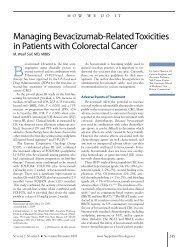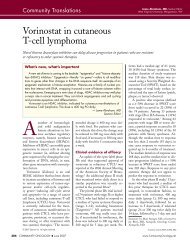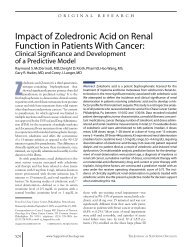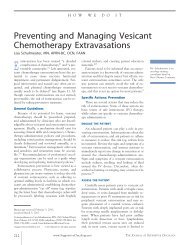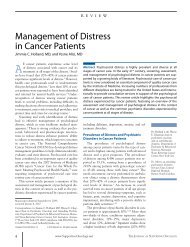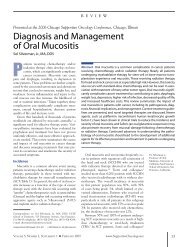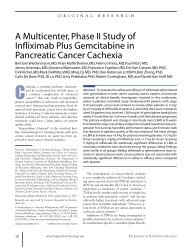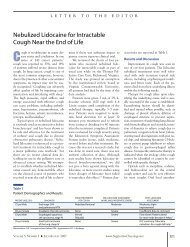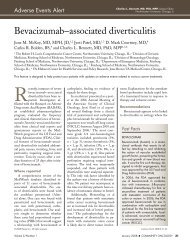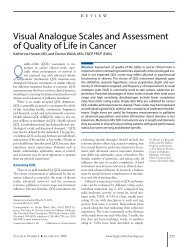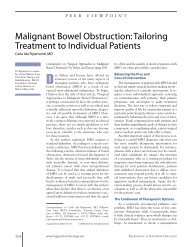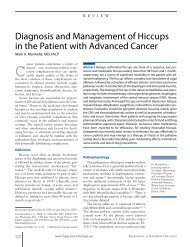Evaluating the “Good Death” Concept from Iranian Bereaved Family
Evaluating the “Good Death” Concept from Iranian Bereaved Family
Evaluating the “Good Death” Concept from Iranian Bereaved Family
You also want an ePaper? Increase the reach of your titles
YUMPU automatically turns print PDFs into web optimized ePapers that Google loves.
<strong>Evaluating</strong> <strong>the</strong> <strong>“Good</strong> <strong>Death”</strong> <strong>Concept</strong><br />
bereaved family members were similar to those in Japan. This<br />
finding thus indicates that <strong>the</strong>se perceptions are foundational<br />
elements of a good death, regardless of ethnicity or cultural<br />
differences.<br />
The results indicated that most family members are<br />
likely to view a good death as “being respected as an<br />
individual” and having “control over <strong>the</strong> future.” According<br />
to Murata, 19 approaching death can cause a sense that<br />
life is meaningless and a loss of <strong>the</strong> patient’s well-being<br />
founded on temporality, relationships, and autonomy. Providing<br />
a good death means that dying patients are able and<br />
allowed to participate in <strong>the</strong> same human interactions that<br />
are important throughout life and appreciating patients as<br />
unique and “whole persons,” not only as “diseases” or<br />
cases. 20 It means supporting patients’ well-being through<br />
positive stimulation, for example, offering beautiful views<br />
and tasty meals. 21 A good death is also perceived by family<br />
members as “religious and spiritual comfort.” Ghavamzadeh<br />
and Bahar 14 claimed that among <strong>Iranian</strong>s religious<br />
beliefs strongly and explicitly deal with <strong>the</strong> fact of death.<br />
This finding reflects <strong>the</strong> result of Tayeb et al, 11 who found<br />
that Muslims believe that death is closely linked to faith.<br />
They appreciated <strong>the</strong> importance of access to any needed<br />
spiritual or emotional support. Steinhauser et al. 20 also<br />
found that 89% of American patients and 85% of <strong>the</strong>ir<br />
families emphasize that a good death is “being at peace<br />
with God” and “prayer.”<br />
Participants perceived a good death as a “natural death.”<br />
Johnson et al 22 claimed that death without “machines,”<br />
“tubes,” and “lines” is considered more dignified and aes<strong>the</strong>tically<br />
pleasing. Withdrawal or withholding of treatment<br />
of <strong>the</strong> highly invasive and technological sort is conceptualized<br />
as restoring patient dignity and, to a small<br />
degree, personhood. 22 Many deaths were not considered<br />
“good” because of inherent problems within a culture of<br />
care that usually strives to prolong life and prevent death. 23<br />
Similarly, Miyashita et al 18 reported that most Japanese<br />
view unnecessary life-prolonging treatments such as vasopressors,<br />
antibiotics, and artificial hydration as barriers to<br />
achieving a good death. The domain perceived by family<br />
members as less important was “unawareness of death.”<br />
This is consistent with Steinhauser et al’s 20 finding that<br />
96% of American patients emphasized “knowing what to<br />
expect about one’s physical condition” achieves a good<br />
death. This is inconsistent with Tang et al’s 24 claims that<br />
in many traditional cultures (eg, most Asian countries and<br />
a few European cultures), in an effort to protect <strong>the</strong> patient<br />
<strong>from</strong> despair and a feeling of hopelessness, family caregivers<br />
often exclude patients <strong>from</strong> <strong>the</strong> process of information<br />
exchange. This is also in contrast to Miyashita et al’s 18,25<br />
findings, where many Japanese do not want to know <strong>the</strong><br />
seriousness of <strong>the</strong>ir condition. Our findings could be explained<br />
by <strong>the</strong> o<strong>the</strong>r results of this study. The results<br />
indicated that <strong>the</strong> majority of participants had a high level<br />
of education. The o<strong>the</strong>r findings showed <strong>the</strong>re is a negative<br />
correlation between level of education and “unawareness of<br />
death.” Since <strong>the</strong> majority of participants were well-educated,<br />
it can be concluded that <strong>the</strong>y were less likely to view<br />
a good death as “unawareness of death.” This has also been<br />
found by Montazeri et al. 26<br />
The results showed that <strong>the</strong> family members’ age was<br />
correlated with some aspects of a good death. Miyashita et<br />
al 18 also found that <strong>the</strong> older <strong>the</strong> family member, <strong>the</strong> more<br />
positively he or she would look on <strong>the</strong> patient’s death.<br />
They claimed that death at younger ages tended to be<br />
evaluated as a bad death. This could be explained by <strong>the</strong>ir<br />
earlier study, where <strong>the</strong>y found that age and psychosocial<br />
maturity inversely related to death anxiety. 27 Based on <strong>the</strong><br />
results, level of education positively influenced some domains<br />
of a good death. There was a negative correlation<br />
between level of education and “unawareness of death,”<br />
with Montazeri et al 26 finding that <strong>Iranian</strong> patients with a<br />
low level of education were more likely to not know <strong>the</strong><br />
diagnosis.<br />
Conclusion<br />
According to <strong>the</strong> results of this study, providing a good<br />
death requires professional caregivers to be sensitive and<br />
pay attention to <strong>the</strong> preferences of each unique person’s<br />
perceptions through her or his senses. This includes views,<br />
tastes, sounds, smells, and bodily contact. The ability of a<br />
dying person to see a sunset may seem petty but is important<br />
in providing high-quality care for people at <strong>the</strong> end of<br />
<strong>the</strong>ir lives. The same goes for <strong>the</strong> o<strong>the</strong>r senses. These<br />
circumstances deserve attention in all educational programs<br />
and especially in programs dealing with end-of-life<br />
care. In order to implement holistic care, caregivers must<br />
pay attention to patients’ spiritual needs. Establishing a<br />
specific palliative care unit in a hospital and meeting each<br />
patient as a unique being and part of a family could be <strong>the</strong><br />
best way to improve <strong>the</strong> quality of end-of-life care that is<br />
missing in Iran. It requires cultural preparation and public<br />
education through <strong>the</strong> media and by well-educated staff.<br />
Since demographic variables influenced <strong>the</strong> evaluation of a<br />
good death <strong>from</strong> <strong>the</strong> bereaved family members’ perspective,<br />
public education needs different strategies.<br />
LIMITATION<br />
All data in this study were collected by use of self-report<br />
questionnaires. The dependence on self-report aspects in<br />
this study may have caused an overestimation of some of<br />
<strong>the</strong> findings due to variance, which is common in different<br />
methods. The respondents were predominantly female,<br />
which limits <strong>the</strong> generalization of <strong>the</strong> results for male<br />
respondents. Moreover, <strong>the</strong> convenience sample of <strong>Iranian</strong><br />
bereaved family members, which is not representative of<br />
<strong>the</strong> entire <strong>Iranian</strong> population, could weaken <strong>the</strong> generalization<br />
of <strong>the</strong> findings. Fur<strong>the</strong>r research is necessary to<br />
illuminate <strong>the</strong> concept of a good death as perceived by <strong>the</strong><br />
general <strong>Iranian</strong> population.<br />
62 www.SupportiveOncology.net THE JOURNAL OF SUPPORTIVE ONCOLOGY



